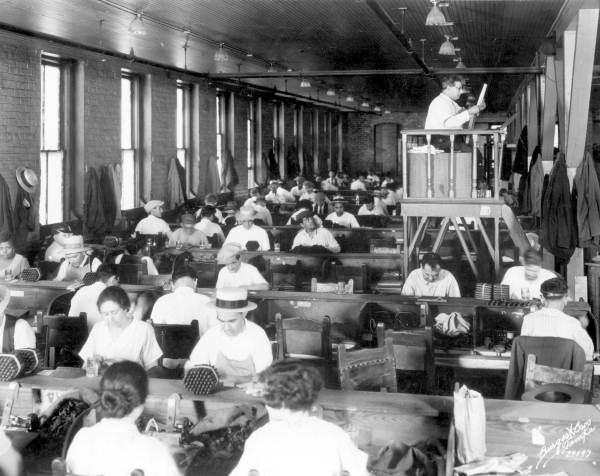The Cigar Industry Changes Florida
Lesson Plans
Photo Analysis: The Lector Reading to Workers
4th Grade Lesson Plan

This lesson has been reviewed and approved by CPALMS.

Lector reading to workers at the Cuesta-Rey Cigar Company in Tampa, Florida (1929)
Overview
Commercial cigar rolling in Florida began with small-scale operations started by Cuban immigrants in the 1830s.
German immigrant and New York cigar manufacturer Samuel Seidenberg established the first “clear Cuban” cigar factory in Key West in 1867. By using Cuban laborers to roll Cuban tobacco, Seidenberg pioneered the idea of making authentic Cuban cigars in America while avoiding the high tariff levied against products from Havana, as well as the trade restrictions imposed by Spain.
There was a strong natural connection between the cigar workers in Key West and Havana, and by the early 1890s, 50,000-100,000 people traveled back and forth annually.
Cuban Cigar Makers Create a New Florida City
Vicente Martinez Ybor, one of the most significant figures in the history of cigar making in Florida, established a cigar factory in Key West in 1869. Ybor had run a very successful cigar manufacturing business in Cuba, but he fled the country after colonial authorities discovered his connections with revolutionaries.
In 1885, he moved his cigar making operation from Key West to Tampa. Steamships could bring tobacco leaves from Cuba for the cigar factories, and Henry Plant's new railroad connected the small town of Tampa to the rest of the country. The area around the cigar factories grew and became known as Ybor City.
Immigrants came not just from Cuba, but from Italy, Spain, and throughout Eastern Europe and Latin America in search of work. At its height in the 1880s, there were more than 100 factories in Key West. By 1910, there were 150 factories in the Tampa area employing more than 10,000 workers. Of the 50,000 residents of Tampa, 14,000 were Cuban, 7,500 were Spanish, and 1,500 were Italian.
The Lector
Strong union culture was an essential aspect of the Cuban cigar factory, upon which many of the Florida factories were modeled.
The Lector was a factory worker, usually selected by fellow workers, to read aloud during work hours to help pass the time and keep the workers’ minds occupied. Although the Lectors read all sorts of materials from fiction to news articles, choices were often very pro-union, in favor of Cuban independence, and in Tampa, increasingly leftist and anti-corporation. By 1931, after years of dispute over the role of Lectors in changing factories, the major Tampa companies banned them once and for all.
Segregation by Race and Gender
Cuban society was not as rigidly segregated by race as in the southern United States. Cuban-Americans of all skin colors in Ybor City worked side by side in the cigar factories and belonged to the same social clubs.
In the 1890s, laws formalizing the segregation of public facilities and businesses, often called “Jim Crow” laws, spread throughout the South. The separation of jobs between white and black workers became more common, and certain specialized jobs became off-limits for black workers.
Jobs in the cigar factories were also sometimes segregated by gender. Some factories limited the most skilled positions to men. Women were often relegated to traditionally female jobs such as "stemmers," those removing the center stem from leaves, whereas men occupied other areas of cigar work such as selecting wrapper leaves.
However, small factories called chinchals employed men and women at all skill levels in order to maximize the work of fewer employees. Women became more commonly employed in skilled positions at large factories by the 1930s, although still working for lower wages.
Florida’s Cigar Heritage
Cigar manufacturing took place in all of Florida's urban areas at some point during the first century of statehood, but its impacts were particularly profound in Key West, and in the Ybor City and West Tampa areas around Tampa Bay.
The cigar industry prospered in Florida during the early decades of the 20th century. A combination of factors caused the industry to decline, however, as time moved forward. Conflicts between organized labor and factory managers slowed production, while new machines were able to turn out cigars much faster and cheaper than the hand-rolling method. Demand for fine cigars decreased during the Great Depression, and by the end of World War II enough cigar factories had closed to make the industry less attractive for returning veterans.
The cigar industry changed the cultural landscapes of cities like Tampa and Key West. Historic districts still feature buildings once dedicated to the art of the hand-rolled cigar, and local histories still count the industry as a critical influence.
Objectives
Students will:
- Analyze primary source documents (photographs).
- Write about history using primary sources.
Grade
4
NGSSS
- SS.4.A.1.1: Analyze primary and secondary resources to identify significant individuals and events throughout Florida history.
- SS.4.A.6.1: Describe the economic development of Florida's major industries.
Examples are timber, citrus, cattle, tourism, phosphate, cigar. - SS.4.A.6.2: Summarize contributions immigrant groups made to Florida.
- SS.4.A.6.3: Describe the contributions of significant individuals to Florida.
Examples may include, but are not limited to, John Gorrie, Henry Flagler, Henry Plant, Lue Gim Gong, Vicente Martinez Ybor, Julia Tuttle, Mary McLeod Bethune, Thomas Alva Edison, James Weldon Johnson, Marjorie Kinnan Rawlings. - SS.4.A.6.4: Describe effects of the Spanish American War on Florida.
Examples may include, but are not limited to, cigar industry, temporary economic boom at Ft. Brooke due to Rough Riders, Cuban immigration. - SS.4.E.1.1: Identify entrepreneurs from various social and ethnic backgrounds who have influenced Florida and local economy. Examples are Henry Flagler, Walt Disney, Ed Ball, Alfred Dupont, Julia Tuttle, Vicente Martinez Ybor.
Florida Standards
- LAFS.K12.R.1.1: Read closely to determine what the text says explicitly and to make logical inferences from it; cite specific textual evidence when writing or speaking to support conclusions drawn from the text.
-
LAFS.4.RI.1.1: Refer to details and examples in a text when explaining what the text says explicitly and when drawing inferences from the text.
Materials Needed
- Lector reading to workers at the Cuesta-Rey Cigar Company in Tampa, Florida, 1929 small JPG | medium JPG | large JPG | TIFF
- Photo Analysis Worksheet from the National Archives and Records Administration
Procedure
Part I: Introducing Content
- Teachers should review what students already know about the cigar industry.
- Tell students that they are going to analyze a photo related to the cigar industry.
Part II: Photo Analysis
- Students will analyze the photograph of the lector reading to workers at the Cuesta-Rey Cigar Company in Tampa, Florida. Students should record their reactions to the photographs using the Primary Source Analyzing Tool.
- The teacher should conduct an in-class discussion/survey of what students learned during the photo analysis.
- What questions come up during the photo analysis? Students might notice:
- The lector reading to the workers.
- Men and women working side-by-side.
Part III: Writing About the Cigar Industry
Students should write brief journal responses to the photograph, focused on what they learned about the cigar industry.

 Listen: The Bluegrass & Old-Time Program
Listen: The Bluegrass & Old-Time Program